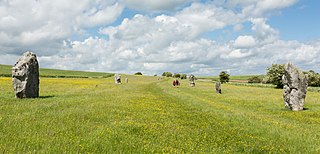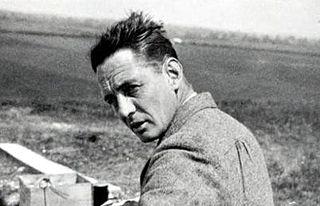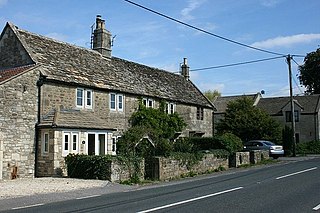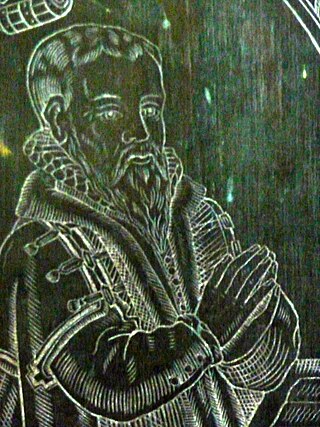
Avebury is a village and civil parish in Wiltshire, England. The village is about 5.5 miles (9 km) west of Marlborough and 8 miles (13 km) northeast of Devizes. Much of the village is encircled by the prehistoric monument complex also known as Avebury. The parish also includes the small villages of Avebury Trusloe and Beckhampton, and the hamlet of West Kennett.

Avebury is a Neolithic henge monument containing three stone circles, around the village of Avebury in Wiltshire, in southwest England. One of the best known prehistoric sites in Britain, it contains the largest megalithic stone circle in the world. It is both a tourist attraction and a place of religious importance to contemporary pagans.

Windmill Hill is a Neolithic causewayed enclosure in the English county of Wiltshire, part of the Avebury World Heritage Site, about 1 mile (2 km) northwest of Avebury. Enclosing an area of 21 acres (8.5 ha), it is the largest known causewayed enclosure in Britain. The site was first occupied around 3800 BC, although the only evidence is a series of pits apparently dug by an agrarian society using Hembury pottery.

The Sanctuary was a stone and timber circle near the village of Avebury in the south-western English county of Wiltshire. Excavation has revealed the location of the 58 stone sockets and 62 post-holes. The ring was part of a tradition of stone circle construction that spread throughout much of Britain, Ireland, and Brittany during the Late Neolithic and Early Bronze Age, over a period between 3300 and 900 BCE. The purpose of such monuments is unknown, although archaeologists speculate that the stones represented supernatural entities for the circle's builders.

Kennet Avenue or West Kennet Avenue is a prehistoric site in the English county of Wiltshire. It was an avenue of two parallel lines of stones 25m wide and 2.5 km in length, which ran between the Neolithic sites of Avebury and The Sanctuary.

The barber surgeon of Avebury is the name given to a skeleton discovered in 1938 at Avebury henge monument in Wiltshire, England.

Berwick Bassett is a small village and civil parish in Wiltshire, England, about 6 miles (10 km) northwest of Marlborough and 8 miles (13 km) southwest of Swindon. The village is on the west bank of a headstream of the River Kennet and close to the A4361 road, formerly the A361, which links Devizes and Avebury with Wroughton and Swindon.

East Kennett is a small village and civil parish in Wiltshire, England, 5 miles (8.0 km) west of Marlborough. The United Kingdom Census 2011 recorded a parish population of 84.

Fonthill Gifford is a village and civil parish in Wiltshire, England, to the north of the Nadder valley, 14 miles (23 km) west of Salisbury.

Alexander Keiller was a Scottish archaeologist, pioneering aerial photographer, businessman and philanthropist. He worked on an extensive prehistoric site at Avebury in Wiltshire, England, and helped ensure its preservation.

Sir Edward Guy Dawber, RA was an English architect working in the late Arts and Crafts style, whose work is particularly associated with the Cotswolds.
Stonehenge, Avebury and Associated Sites is a UNESCO World Heritage Site (WHS) in Wiltshire, England. The WHS covers two large areas of land separated by about 24 kilometres (15 mi), rather than a specific monument or building. The sites were inscribed as co-listings in 1986. Some large and well known monuments within the WHS are listed below, but the area also has an exceptionally high density of small-scale archaeological sites, particularly from the prehistoric period. More than 700 individual archaeological features have been identified. There are 160 separate scheduled monuments, covering 415 items or features.

Lytes Cary is a manor house with associated chapel and gardens near Charlton Mackrell and Somerton in Somerset, England. The property, owned by the National Trust, has parts dating to the 14th century, with other sections dating to the 15th, 16th, 18th, and 20th centuries. "Yet all parts blend to perfection with one another and with the gentle sunny landscape that surrounds them," comments Nikolaus Pevsner. The House is listed as Grade I by English Heritage.

Wingfield is a small village and civil parish in the county of Wiltshire, England, about 2.5 miles (4.0 km) south of Bradford-on-Avon and 2.2 miles (3.5 km) west of Trowbridge.

William Dunch (1508–1597) was an English politician, a local official in the counties of Berkshire and Oxfordshire and Auditor of the Royal Mint for Kings Henry VIII and Edward IV.
Avebury Priory was an alien house of Benedictine monks in Wiltshire, England, between the early 12th century and the Dissolution.
Sir William Button, 1st Baronet was an English landowner who sat in the House of Commons at various times between 1614 and 1629. He supported the Royalist cause in the English Civil War.
Thomas Lambert (1585–1638) was an English landowner who briefly sat in the House of Commons from 1625 to 1626.
James Marvyn (1529–1611), of Fonthill Gifford, Wiltshire, was an English politician.
Harold St George Gray was a British archaeologist. He was involved in the Pitt Rivers Museum in Oxford and later was the librarian-curator of the Museum for the Somerset Archaeological and Natural History Society.















